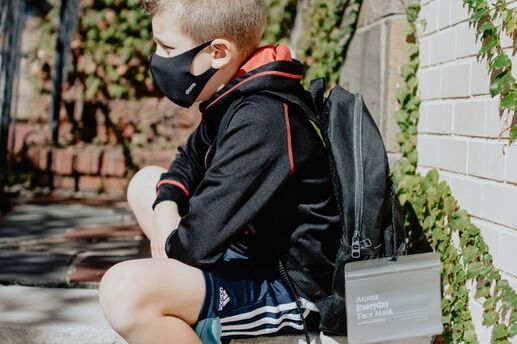7 Back-to-school Essentials for a Healthier New Year
With summer coming to an end and the first day of school on the horizon, now’s the time for back-to-school shopping. Along with the usual notebooks and pens, experts recommend a few staples, such as pocket-size hand sanitizers and boxes of tissues, to keep your kids safe and healthy. So before you hit the stores, consider adding the items below to your school supply list.
1. A padded backpack. Kids choose their backpacks for color and style, so it’s up to parents to ensure they make the safest pick. A heavy or ill-fitting bag can pull on muscles and ligaments, says Dr. Danielle Cooley, an osteopathic family physician and assistant professor at the University of Medicine and Dentistry of New Jersey School of Osteopathic Medicine. That can lead to neck and back pain -- and, over time, even spinal problems. When choosing a backpack, Cooley recommends looking for:
· A padded back. The cushioning helps to protect the back and relieve the strain of carrying a heavy load.
· Wide, padded straps. “Narrow straps dig into the shoulders,” says Cooley. Adjust the straps so that the bag rests in the middle of your child’s back. A bag that hangs too low on the spine can lead to misalignment, pain and posture problems, such as sway back, explains Cooley.
· Multiple compartments. Extra pockets help evenly distribute the weight of the books and supplies. According to the American Academy of Pediatrics, a full backpack should weigh no more than 10 to 20 percent of your child’s bodyweight (for a 60-pound child, that’s around 10 pounds). So encourage your daughter to swap books in her locker between classes.
2. Sunscreen or sun-protective clothing. “Don’t forget the sunscreen for those bright days, especially at the start of the school year,” says Dr. Lisa Martin, an associate professor of pediatrics at Loyola University Stritch School of Medicine and a pediatrician at Loyola University Health System in Chicago. Recess tends to be scheduled between 10 a.m. and 2 p.m., when the sun’s rays are the strongest. And just one bad burn can double your child’s chances of developing melanoma -- the most dangerous form of skin cancer -- later in life, reports the National Cancer Institute.
But before you slip that sunscreen into your kids’ backpacks, check with the school administration. Because the FDA regulates sunscreen as an over-the-counter drug, some districts require a doctor’s note or don’t allow children to apply it at school. If that’s the case, make sure to apply a sunscreen of at least SPF 15 before sending them off in the morning.
3. Medication refills. If your child has a condition that may require treatment in school (such as asthma or food allergies), make sure to have a new refill to give the school nurse at the start of the school year. “You don’t want them to have an expired medication if there’s an emergency,” says Martin.
4. Alcohol-based hand sanitizer. The average child comes down with six to eight colds a year, and many of those viruses are spread in the classroom, says Martin. The best way to protect against those germs: Teach kids to wash their hands after bathroom breaks, recess and gym class, as well as before eating.
Unfortunately, many children forget that lesson. In fact, a University of Pennsylvania study found that only about half of middle- and high-school students scrub up after using the restroom! The solution? Pack pocket-size containers of hand sanitizer in your child’s backpack, so she can fend off germs throughout the day.
5. Tissues. To prevent the spread of germs, make sure your child always has a box of tissues on hand (bonus: they come in fun back-to-school designs, so your kids will be excited to use them!). And teach him to sneeze or cough into one: In two out of three cases, people sneeze into their hands, show researchers from New Zealand. But that practice contaminates the hands, which may infect all the surfaces your child touches in the classroom. (Caught without a tissue? Remind him to sneeze or cough into the crook of his elbow.) Your kid can also use those tissues to wipe down his desk daily.
6. Insulated lunch bag. A turkey-and-cheese sandwich is a brown bag staple, but it can also turn into a breeding ground for bacteria if it’s not kept at the proper temperature. Because of their developing immune systems, children are up to five times more likely to develop a case of food poisoning than the average adult, reports research in the journal Pediatrics.
That’s why it’s important to keep their midday meals cool. Pack their lunches in an insulated bag, and store them in the fridge until they head out the door. “Using an ice pack can also help prevent food-borne illness,” says Martin.
7. Breakfast staples. While you’re scrambling to get used to your new school schedule, make sure a healthy breakfast isn’t lost in the morning scramble. Studies show that kids who fuel up before their first class learn -- and retain -- more than those who skip the meal. And what you put on that plate makes a difference too: Dining on oatmeal boosts brainpower more than eating a sugary cereal, according to a Tufts University study. That’s because oatmeal delivers longer-lasting energy, which may help your child pay closer attention in her morning classes.
Martin recommends stocking up on portable breakfast staples that your kids can grab if they’re running late. A few options: drinkable yogurt, fruit, whole-grain cereal (pre-portioned into bags) and breakfast bars.
Like this article? Get more by following us on Facebook at Beauty & Confidence.




